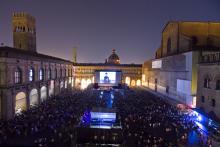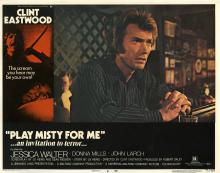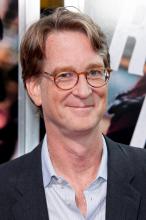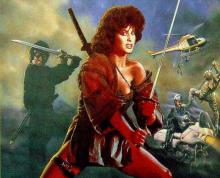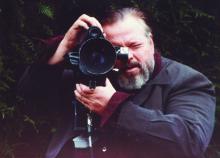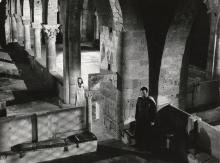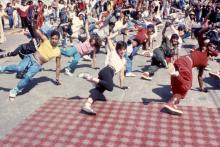By Jim Healy, Director of Programming, UW Cinematheque & Wisconsin Film Festival
This coming Friday and Saturday, March 20 & 21, the Cinematheque will offer a small sampling of one of the world’s greatest Film Festivals, Il Cinema Ritrovato. Held annually in Bologna, Italy over eight days during the early summer, Il Cinema Ritrovato (“Rediscovered Cinema”) is the leading event in the realm of retrospective and repertory festivals and is presented by that mecca for film culture and preservation, the Cineteca di Bologna.
I am increasingly convinced that there are no “old” or “new” movies, just movies I have or have not seen, and that the only true test of a movie’s greatness is how it holds up 40, 50, even 100 years after its first release. The sheer volume of great movies that I have been able to see during my three visits so far to Il Cinema Ritrovato has reinforced my faith in cinema’s past. At this feast for cinephiles, you don’t have to rigorously plan your viewing or worry about catching up with the “buzz”. All you need to do is place yourself in the capable hands of the tasteful and knowledgeable programmers, who have been, for the most recent editions, the late cinema historian and filmmaker Peter von Bagh; the Cineteca di Bologna’s Director, Gian Luca Farinelli; the celebrated curator Mariann Lewinsky; and Il Cinema Ritrovato’s Festival Coordinator, Guy Borlée, among others.
Il Cinema Ritrovato programming usually contains some focus on Japanese cinema (last year was a selection of the best early sound films from Japan) and a series that offers highlights of moviegoing from exactly 100 years ago. Plus, “Ritrovati e Restaurati” (“Recovered and Restored”), an annual selection that brings not just new restorations of canonized titles, but the new prints and DCPs are usually accompanied by the leading names in film preservation and restoration, who are present to discuss their valued work. The most recent edition of Ritrovati e Restaurati, in 2014, included scrubbed-up versions of A Hard Day’s Night (1964) and Orson Welles’s The Lady from Shanghai (1948), both of which are Cinematheque selections this spring; Plus: Carne’s Le Jour se Leve (1939); Paradjanov’s The Color of Pomegranates (1969), and two titles that will play in our upcoming Wisconsin Film Festival: The Cabinet of Dr. Caligari (1919) and Ettore Scola’s black comedy Il Piu bella serrata della mia vita (The Most Beautiful Evening of My Life, 1971).
To name just a few of the many personal viewing highlights and discoveries since my first trip to Bologna in 2011: retrospectives of the somewhat forgotten Italian directors Riccardo Freda and Luigi Zampa, particularly Zampa’s 1954 Gina Lolobrigida vehicle, La Romana and Freda’s medieval family melodrama, Beatrice Cenci (1956); a program of 16mm “soundies” – short musical performances made for vintage video jukeboxes; a Howard Hawks tribute that placed an emphasis on the legendary Hollywood director’s earlier work, especially his hard-to-see movies from the silent era; a series focusing on French auteur Jean Gremillon that revealed him to be, for me, the equal of Jean Renoir; von Bagh’s “Cinema at War Against Hitler” program, which introduced me to John Farrow’s The Hitler Gang (1944) and Frank Tuttle’s The Magic Face (1951); and a selection of the best episodes from Italian omnibus features (in particular Guglielmo il dentone, Luigi Filippo D’Amico’s hilarious episode from Il Complessi (1965) starring Alberto Sordi).
I am also continually impressed with the highly civilized fashion in which films are presented. Viewers usually have to choose between one of four venues: the two screens at the Cineteca di Bologna’s campus and the larger sized Cinemas Jolly and Arlecchino. The first morning screenings usually begin around 9 a.m. and the last morning sessions usually end around 1 p.m. This gives all festival-goers a 60-90 minute lunch break before the first afternoon sessions begin around 2:30. The afternoon and early evening screenings usually wrap up around 7 or 8 p.m., which gives everyone a 2 or 3-hour dinner break before the final screening of the evening begins at 10:30 p.m. in the magnificent outdoor setting of Bologna’s grand Piazza Maggiore (see attached picture). Attendance at Il Cinema Ritrovato has been on the rise over the last few editions and the festival organizers might want to take a closer look at managing the growing queues, especially at the smaller venues. That said, the crowds are usually of a manageable size and it is very easy to see five or six movies a day without much stress. An all-festival pass, which also includes admission to dozens of discussion sessions and panels with filmmakers, critics and preservationists, is quite a bargain at less than 100 Euros.
At our Cinematheque event this weekend we will welcome Il Cinema Ritrovato’s Festival Coordinator, Guy Borlée, who will present four programs of movies all restored at Cineteca di Bologna and screened at a recent edition of the festival. On Friday, March 20 at 7 p.m., our series begins with two landmarks in African cinema, Ousmane Sembene’s short Borrom Sarret (1969) and Djibril Diop Mambéty’s Senegalese feature, Touki Bouki (1973).
On Saturday, March 21, Borlée will introduce three very different movies: at 2 p.m., Love Everlasting (Ma L’amour Mio Non Muore!, 1913), a silent vehicle for one of the great divas of the Italian stage, Lyda Borelli; at 4 p.m. an American underground classic, not seen for many years, Brand X (1970), conceived and directed by the late Wynn Chamberlain; and at 7 p.m., one of the great masterpieces of all time, Roberto Rossellini’s Viaggio in Italia, starring Ingrid Bergman and George Sanders.
Perhaps our screenings will whet your appetite and inspire a trip to Bologna this June/July when Il Cinema Ritrovato will present its 29th edition. Plans for this year include salutes to comedy and melodrama master Leo McCarey and the early movies of Ingrid Bergman; “The Soviet Thaw 1953-1957”; “Jazz Goes to the Movies”; and early Japanese color cinema. You can read more about the upcoming edition and purchase your festival passes here.

